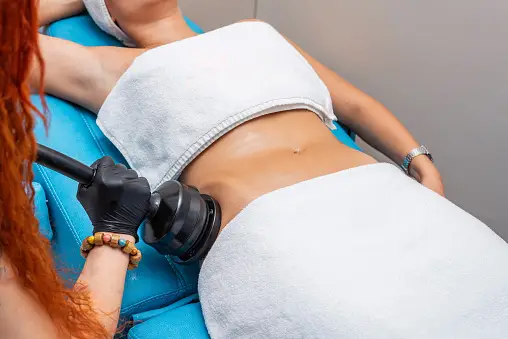When deciding on a skin tightening treatment, it’s important to consider several factors to determine the best option for you. Here are some key points to help you make an informed decision:
- Consultation with a Dermatologist or Cosmetic Specialist: Schedule an appointment with a qualified professional who can assess your skin condition, concerns, and overall health. They will be able to recommend suitable treatment options based on your individual needs.
- Understand Your Goals: Clearly define your desired outcomes. Are you targeting sagging skin on the face, body, or both? Do you have any specific concerns, such as wrinkles, cellulite, or loose skin? Understanding your goals will help guide you towards the appropriate treatment.
- Research Treatment Options: There are various skin tightening treatments available, including non-invasive and minimally invasive options. Research the different procedures and techniques, such as radiofrequency, ultrasound, laser treatments, or surgical options like facelifts. Learn about their benefits, effectiveness, potential side effects, and downtime associated with each.
- Consider Your Skin Type and Condition: Certain treatments may be more suitable for specific skin types or conditions. For example, radiofrequency and ultrasound treatments are generally safe for all skin types, while laser treatments may have limitations for darker skin tones. Discuss any existing skin conditions or sensitivities with your healthcare professional to ensure the chosen treatment is compatible with your skin.
- Evaluate Treatment Costs: Cost can be a significant factor in your decision-making process. Different treatments vary in price, and some may require multiple sessions for optimal results. Consider your budget and weigh it against the expected outcomes to determine what you can afford.
- Review Before and After Photos: Request to see before and after photos of patients who have undergone the treatments you are considering. This will give you a visual representation of the potential results and help manage your expectations.
- Understand Potential Risks and Side Effects: Each treatment option carries its own risks and potential side effects. Research and discuss these aspects with your healthcare professional to ensure you are well-informed about any possible complications.
- Lifestyle and Downtime: Consider your lifestyle and availability for downtime after the treatment. Some procedures may require minimal to no downtime, while others may involve a recovery period with temporary restrictions on activities, such as avoiding sun exposure or strenuous exercise.
- Patient Experiences and Reviews: Look for reputable sources, patient testimonials, or online reviews from individuals who have undergone the treatments you are considering. While personal experiences can vary, this information can provide additional insights and help you make a more informed decision.
Remember, it’s crucial to consult with a qualified professional who can evaluate your specific needs and guide you towards the most suitable skin tightening treatment for your individual case.

What age should you start skin tightening?
The appropriate age to start skin tightening treatments can vary depending on individual factors such as genetics, lifestyle, and overall skin condition. In general, most people consider skin tightening treatments as they start to notice visible signs of aging, such as sagging skin, fine lines, or wrinkles. However, there is no specific age requirement for initiating these treatments.
The early signs of skin aging typically begin to appear in the late 20s to early 30s, and this is when preventive measures like proper skincare, sun protection, and a healthy lifestyle become important. However, non-invasive skin tightening treatments are often more common in individuals in their 40s or older when the effects of aging become more pronounced.
It’s essential to note that the choice to undergo skin tightening treatments should be based on an individual’s specific concerns and goals, rather than a specific age range. If you’re considering skin tightening treatments, it’s recommended to consult with a dermatologist or cosmetic specialist who can assess your skin condition and provide personalized recommendations based on your unique needs. They will be able to guide you on the appropriate timing for initiating skin tightening treatments based on your skin’s specific characteristics and aging process.
What is the best type of skin tightening treatment?
Determining the “best” type of skin tightening treatment depends on various factors, including your individual needs, skin condition, and preferences. There isn’t a one-size-fits-all answer as different treatments offer different benefits and results. Here are a few popular skin tightening treatments to consider:
- Radiofrequency (RF) Treatments: RF treatments use radiofrequency energy to heat the deep layers of the skin, stimulating collagen production and resulting in skin tightening. These treatments are non-invasive, have minimal downtime, and can be used on various body areas.
- Ultrasound Treatments: Ultrasound treatments deliver focused ultrasound energy to target specific areas of the skin, promoting collagen regeneration and tightening. This type of treatment is non-invasive and commonly used for facial and neck rejuvenation.
- Laser Treatments: Laser treatments use focused laser energy to heat the skin and stimulate collagen production, resulting in improved skin tightness. Different laser technologies are available, such as fractional lasers or ablative lasers, and their suitability depends on the specific concerns and skin type.
- Microneedling with Radiofrequency: This treatment combines microneedling, which creates tiny punctures in the skin to stimulate collagen production, with radiofrequency energy to further enhance skin tightening and rejuvenation.
- Surgical Procedures: For more significant skin laxity, surgical procedures like facelifts, neck lifts, or body lifts can provide more dramatic and long-lasting results. These procedures involve the removal of excess skin and tightening of underlying tissues.
It’s important to consult with a qualified dermatologist or cosmetic specialist who can evaluate your skin condition, discuss your goals, and recommend the most suitable treatment option for you. They will consider factors such as your skin type, desired outcomes, budget, and any potential risks or downtime associated with each treatment. Ultimately, the best treatment for you will depend on a personalized assessment and discussion with a healthcare professional.
What is the difference between skin tightening and lifting?
While the terms “skin tightening” and “skin lifting” are often used interchangeably, they can refer to slightly different aspects of rejuvenating the skin. Here’s a breakdown of the key differences between the two:
Skin Tightening: Skin tightening primarily focuses on improving the firmness, elasticity, and overall tightness of the skin. It aims to reduce sagging or laxity in the skin by stimulating collagen production, which provides structural support to the skin. The goal of skin tightening treatments is to improve skin tone and texture, minimize fine lines and wrinkles, and enhance overall skin firmness. Common techniques for skin tightening include radiofrequency treatments, ultrasound treatments, laser treatments, and microneedling with radiofrequency.
Skin Lifting: Skin lifting, on the other hand, involves addressing deeper layers of the skin, specifically the underlying facial or body tissues, to restore a more youthful and lifted appearance. It targets sagging or drooping skin by repositioning or tightening the underlying tissues to create a more lifted effect. Skin lifting procedures are often surgical in nature and may include facelifts, neck lifts, or body lifts. These procedures involve removing excess skin and tightening the underlying muscles and tissues to achieve a more defined and lifted appearance.
In summary, while both skin tightening and skin lifting aim to improve the appearance of the skin, skin tightening focuses more on enhancing firmness, elasticity, and texture, while skin lifting involves surgical or invasive procedures to reposition and tighten the deeper structures for a more lifted and youthful look. The choice between these approaches depends on the severity of skin laxity, individual goals, and preferences, and should be discussed with a qualified healthcare professional to determine the most appropriate treatment option for you.
